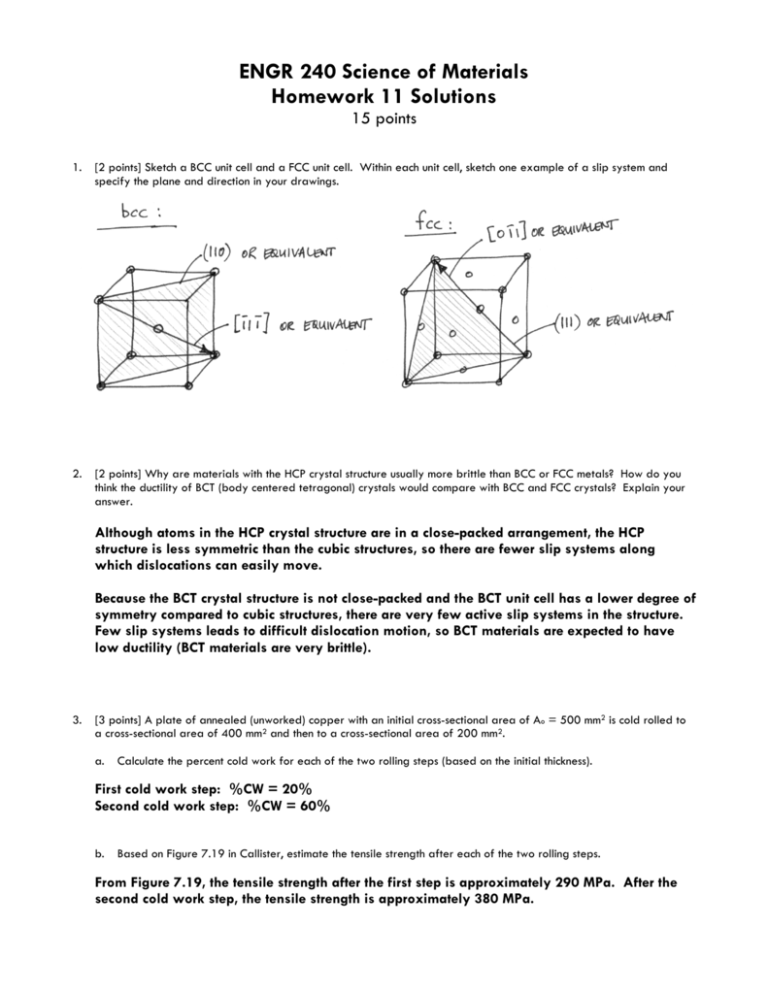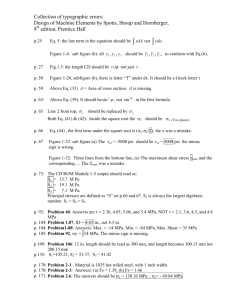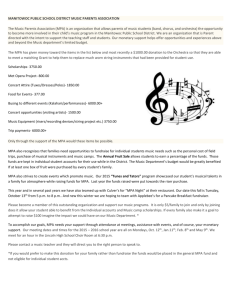Document
advertisement

ENGR 240 Science of Materials Homework 11 Solutions 15 points 1. [2 points] Sketch a BCC unit cell and a FCC unit cell. Within each unit cell, sketch one example of a slip system and specify the plane and direction in your drawings. 2. [2 points] Why are materials with the HCP crystal structure usually more brittle than BCC or FCC metals? How do you think the ductility of BCT (body centered tetragonal) crystals would compare with BCC and FCC crystals? Explain your answer. Although atoms in the HCP crystal structure are in a close-packed arrangement, the HCP structure is less symmetric than the cubic structures, so there are fewer slip systems along which dislocations can easily move. Because the BCT crystal structure is not close-packed and the BCT unit cell has a lower degree of symmetry compared to cubic structures, there are very few active slip systems in the structure. Few slip systems leads to difficult dislocation motion, so BCT materials are expected to have low ductility (BCT materials are very brittle). 3. [3 points] A plate of annealed (unworked) copper with an initial cross-sectional area of Ao = 500 mm2 is cold rolled to a cross-sectional area of 400 mm2 and then to a cross-sectional area of 200 mm2. a. Calculate the percent cold work for each of the two rolling steps (based on the initial thickness). First cold work step: %CW = 20% Second cold work step: %CW = 60% b. Based on Figure 7.19 in Callister, estimate the tensile strength after each of the two rolling steps. From Figure 7.19, the tensile strength after the first step is approximately 290 MPa. After the second cold work step, the tensile strength is approximately 380 MPa. c. Compare the tensile strengths of the rolled copper to the strength of annealed copper by calculating the percent increase in the strength due to the two cold rolling steps. The strength of annealed copper (0% cold work) is approximately 220 MPa, so the increases in strength are as follows: First step: 32% increase in strength Second step: 73% increase in strength (compared to initial, annealed condition) 4. [2 points] Callister Problem 7.19 – grain boundary strengthening. 7.19 (a) Perhaps the easiest way to solve for s and k in Equation (7.5) is to pick two values each of s and d o y y 1/2 from Figure 7.15, and then solve two simultaneous equations, which may be set up. For example -1/2 -1/2 d (mm) s (MPa) y 75 175 4 12 The two equations are thus 75 = s + 4k o y 175 = s + 12k o y These yield the values of k = 12.5 MPa(mm) y 1/2 [1810 psi(mm)1/2] s = 25 MPa (3630 psi) o (b) When d = 1.0 x 10 -3 mm, d -1/2 = 31.6 mm -1/2 , and, using Equation (7.5), -1/2 s =s +k d y o y [ ] 1/2 -1/2 = (25 MPa) + 12.5 MPa(mm) (31.6 mm ) = 420 MPa (61,000 psi) 5. [2 points] Use a graphing program such as Excel to plot yield strength (in MPa) versus grain size (in µm) for jewelry bronze with grain sizes of 1 to 100 µm. For strength given in MPa and grain size in µm, the constants σo and k for jewelry bronze are 200 MPa and 300, respectively. Jewelry bronze has a composition of 87.5% Cu and 12.5% Zn (in case you were wondering). 550 Yield Strength (MPa) 500 450 400 350 300 250 200 0 10 20 30 40 50 60 70 80 90 100 Grain Size (µ m) 6. [2 points] Is it possible to strengthen lead by cold rolling at room temperature? Explain your answer. No, lead will not strain harden at room temperature since its recrystallization temperature is below room temperature (see Table 7.2 on p. 176) 7. [1 point] How does increasing percent cold work affect the recrystallization temperature? As the percent cold work increases, the recrystallization temperature will decrease. High amounts of strain hardening lead to high dislocation densities and high strain energy in the cold worked material (more dislocations = more strain fields = higher energy state (atoms are not where they want to be)). With a high degree of strain energy due to cold work, atoms require less thermal energy to rearrange themselves into new, strain-free crystals during the recrystallization stage of annealing. 8. [1 point] Would the recrystallization temperature for pure Cu be higher or lower than the recrystallization temperature for a Cu-Zn brass alloy? Pure materials generally exhibit lower recrystallization temperatures than their alloys due to higher diffusion rates in pure materials compared to alloys (atoms can more quickly rearrange into new crystals during the recrystallization stage of annealing).









